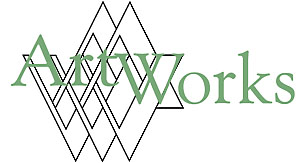
 |
Winter 2002-03 |
|
Mullens mural painter Accessible recreation guide Following the dream Disabilities guidance Cultural Facilities grant awards |
Mullens mural painter inspires a whole townBy Tim McGhee When Roger Waters of Pink Floyd sees kids and a wall, he admonishes the adults of their lives for being just another brick. When Bill McGhee of Mullens sees kids and a wall, he gives the kids paintbrushes and encourages them to create. A long-time versatile craftsman, McGhee has among other things built ships in bottles. Someone drains booze, and McGhee puts the Golden Hind back in. There are many paintings of the crucifixion of Jesus Christ. McGhee did an oil of the crucifixion of the repentant thief. In short, my dad sees something where there is nothing. And to most of us, there is nothing more nothing than a wall. So, as they say in Hollywood, pan the wall and fade to the mural. The story of how a whole town became muralists has a humble beginning. After watching McGhee paint small religious murals in churches around Mullens in the 1980s, town leader Jack Feller had an idea. He posed a question: There are a lot of bare, ugly walls in this town, what can we do about them? As with most everything else, my dad’s response was to put art on them. But he made one stipulation: “I didn’t want them to be my paintings. I wanted the people of the city to share in them.” Feller approached the town’s beautification committee. He’s a good salesman, so money was appropriated for paint, brushes and scaffolding for first mural. Donations covered the balance, and in 1989 the denizens of Mullens got ready to do their rendition of vertical Michelangelos. Feller and McGhee chose a 90-foot-long and 20-foot-high wall on the side of a local doctor’s building. The volunteer fire department treated the surface with three thorough high-pressure washings. Meanwhile, McGhee conceived the painting. For over 35 years he had fired and engineered locomotives for both the Virginian and the Norfolk and Western Railways, spanning the steam, electric and diesel eras. His favorite was a Richmond 215 Pacific type with six 70-inch drivers, a beautiful machine one of my grandfathers used to coast into Mullens on, where he would hand it over to my other grandfather, the boilermaker. McGhee sketched that Richmond 215 coming out of the tunnel on the west end of town.
McGhee’s sketch was drawn on paper to scale on a grid. Another grid was placed on the wall with plumb bobs and levels. The artist popped chalk lines, sketched the wall, and started painting. It didn’t take people long to figure out they were truly invited to this party. Many times ten to 15 people, and at one time up to 25, brought their own brushes and dipped into the 32 gallons of red, yellow, blue, black and white masonry paint. Some even brought their own paint. In four months, the mural was completed and ceremoniously unveiled. Then what? That’s easy: He did another one. After painting a 20-foot by 35-foot fire engine mural on the side of the volunteer fire department, McGhee looked at the rear wall of the town’s Veterans’ Building and envisioned a 35-foot by 54-foot detailed scene of Mullens from the aspect of City Hall in the year 1916. Local folks participated in both the painting and the design of this mural. McGhee needed something on which to model a period Ford that founding father A. J. “Uncle Jack” Mullins drove. A lady proudly presented a photograph of the automobile. At one point, McGhee wanted to paint a hound dog. Another woman suggested a Dalmatian. “I said I’d do it,” McGhee says, “but I didn’t know how many spots were on the dog. I was just joking with her. She called her brother in Ohio to have him count the spots on his dog. She reported back, ‘He doesn’t know, but he wanted me to tell you to make sure the tail has spots.’ You see, everybody was in on this.” Art comes from the soul. He won’t admit it, but I know my dad’s personal experiences shaped his vision of murals to honor veterans. He spent his 22nd birthday as a Marine sergeant in the battle of Guadalcanal. He knows how it feels to carry a rifle and to have one aimed at him. He and Feller, also a veteran, researched the participation of Mullens citizens in the wars. McGhee the supervised the painting of 15 eight-foot by ten-foot murals inside the Veterans’ Building depicting all wars and conflicts; even the Spanish-American War was included. One early resident of Mullens rode with Teddy Roosevelt. The rich heritage of the city’s ancestors in two wars is on those walls, alongside a mural honoring those who fought in Desert Storm. Patriotism seemed to give people the impetus to put their time into these murals. One day, 50 school children showed up with brushes. There were so many, a local furniture store provided mattresses to be placed on the floor so the kids could be comfortable as they painted. In July, 2001, Mullens suffered a huge property loss in the waves of unprecedented flooding. Although the high water mark reached several feet above the bottom of the murals, they survived. That summer, the murals may have provided a rallying point, a place to start again. As Mullens is once again thriving, I proposed my theory to my dad. His response: “These people around here didn’t know they were such good painters.” Author Tim McGhee lives in Charleston. Contact him at 1806 Rolling Hills Road, Charleston WV 25314, or call 304-345-6872. |